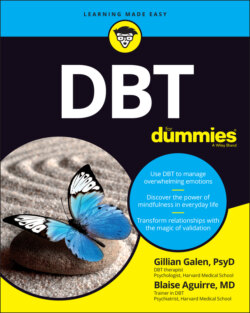Читать книгу DBT For Dummies - Gillian Galen - Страница 72
Choosing instead of reacting
ОглавлениеMany of our responses to events are reactions rather than choices. The problem is that these reactions aren’t always the best course of action. The consequences of these reactions may be that they keep people stuck in misery or even worsen the situation, including adversely impacting the quality of relationships.
We often react without thinking. This is most likely an evolutionary response. If a snake were to cross our path, we wouldn’t want to stop and ponder the nature of the snake and wonder whether it was poisonous. In many situations it actually makes sense to just react. However, if our responses are based simply on our fears and insecurities, then those responses are often not in our long-term interests.
Choosing, on the other hand, is taking all the elements of a situation into consideration before then deciding on the best course of action. This includes integrating values, long-term goals, emotions, current circumstances, and so on.
A more concrete example is that your best friend goes to a party and doesn’t mention to you that she is going. You immediately react by angrily calling her. Now both of you are upset. You have worsened the relationship, which is likely inconsistent with your values and relational goals.
If instead you choose your response, you’ll notice your anger reaction. You can then use the STOP skill (see Chapter 11), which essentially asks you to pause, take a breath, and reflect on the situation. Do you know all that was going on with your friend? Do you know her intentions? Was it her goal to reject or disregard you? Does it help you to dwell on what happened? The choice might then be to call her and say that you were feeling hurt about not having been told about it, or to let her know that you were confused. Or you may even just let it go, knowing that your best friend may have had a good reason for not having invited you, and that she cares deeply about you.
The DBT practice of mindfulness (see Chapter 9) is key to the practice of choosing. This is because it entails noticing our reactions to the things that happen in our lives. The task is then to pause without an immediate reaction. The fact that we have an internal reaction doesn’t mean that we have to respond to it. We can notice the urge without acting on it. And then, on noticing it, we can decide that in fact it was the wise choice or that it was not, or that we can simply notice the urge. Choice is sometimes the choice to not do anything at all.
After the pause, pay attention to the reaction urge. You’ll notice that it passes. Everything always passes. It is the nature of impermanence that it will pass. Eventually it will go away altogether. Think about all the urges that you have ever had in the past. Where are they now? They have all passed. Once the urge has passed, the task is to consider what the wise and — if dealing with another person — compassionate response would be. Ask yourself: “What response will help my relationship?” and “What response will help me stick to my values and reach my long-term goals?”
The practice of choosing rather than reacting takes time, because it requires the observation of the reaction urge without actually reacting. The best way to do this is to set an intention and then practice with little urges to get the feel of the practice before tackling bigger urges.
